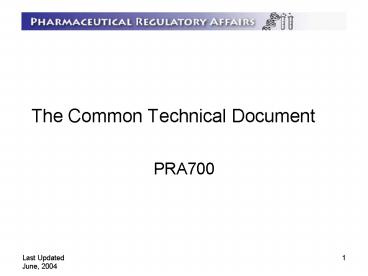The Common Technical Document - PowerPoint PPT Presentation
1 / 29
Title:
The Common Technical Document
Description:
Each section, subsection and/or document within a module should be separated by ... Acronyms and Abbreviations. Define the first time they are used in each module. ... – PowerPoint PPT presentation
Number of Views:1360
Avg rating:3.0/5.0
Title: The Common Technical Document
1
The Common Technical Document
- PRA700
2
Common Technical Document
- The CTD is an ICH Document called M4.
- Organization of the Common Technical Document for
Registration of Pharmaceuticals for Human use. - Step 4 (finalized version) issued in November
2000 - Consists of 4 component guidance's.
- PRIMARY ROLE IS TO INDICATE WHERE AND HOW
AVAILABLE INFORMATION IS TO BE PRESENTED.
3
New Guidance's from TPD
- Preparation of Drug Submissions in the CTD
format (final) - Preparation of Bioequivalence Information for
Drug Submissions in the CTD format (final) - Preparation of Quality Information for Drug
Submissions in the CTD format. (draft)
4
New Templates from TPD
- Quality Overall Summary -Chemical Entities (NDS
and ANDS) (QOS-CE (NDS) (final) - QOS-CE Analytical Procedures and Validation
Information Summaries (final) - Certified Product Information Document Chemical
Entities (CPID-CE) (final) - Certified Product Information Document (Biotech)
(CPID (Biotech)) in CTD Format (draft)
5
Guidances
- Intended to integrate the CTD within the CDN drug
regulatory framework by describing regional
administrative (module 1) and general filing
requirements. - Intended to be used in conjunction with CTD
guidance. - Only address format issues.
- All documents may be used to develop CTDs.
6
Common Technical Document
- May by used as of July 1, 2001
- MUST be used as of July 1, 2003.
- Applies to
- New Drug Submissions
- Abbreviated New Drug Submissions
- Supplemental New Drug Submissions
- Supplemental Abbreviated New Drug Submissions
- Notifiable Changes
7
Common Technical Document
- CTD format is permitted for subsequent filings
regardless of the format of the previous
submission. - The CTD is intended to last the entire life of
the product. This idea reflects back to the idea
that the ultimate goal is to be totally
electronic.
8
SCOPE OF THE CTD
- As developed by the ICH, the CTD is limited to
products covered by Q6A and Q6B - Chemical Entities and Well Characterized Biotech
Products
9
(No Transcript)
10
(No Transcript)
11
Overall Structure of the CTDModule 1
- Module 1 Administrative Information and
Prescribing Information - 1.1 Table of Contents (Module 1 0r 1-5)
- 1.2 Application Forms, Certification, and
Regulatory Status. - 1.3 Product labeling
- 1.4 Summaries
- 1.5 Electronic Copies
12
Overall Structure of the CTDModule 2
- Module 2 CTD Summaries
- Overall CTD Table of Contents (Modules 2 5)
- 2.2 Introduction
- 2.3 Quality Overall Summary
- 2.4 Nonclinical Overview
- 2.5 Clinical Overview
- 2.6 Nonclinical Summary
- 2.7 Clinical Summary
13
Overall Structure of the CTDModule 3
- Module 3 Quality
- 3.1 Module 3 Table of Contents
- 3.2 Body of Data
- 3.3 Literature References
14
Overall Structure of the CTDModule 4
- Module 4 Nonclinical Study Reports
- 4.1 Module 4 Table of Contents
- 4.2 Study Reports
- 4.3 Literature References
15
Overall Structure of the CTDModule 5
- Module 5 Clinical Study Reports
- 5.1 module 5 Table of Contents
- 5.2 Tabular listing of Clinical Studies
- 5.3 Clinical Study Reports
- 5.4 Literature References
16
Presentation of Submissions
- PRA 700
17
Paper Submissions
- Serve as the official Central Registry copy until
TPD is ready to accept submissions in eCTD Format.
18
Binding
- Three Ring binders should be used for all Modules
- Colour Coded
19
(No Transcript)
20
- Labeling of binders
21
Table of Contents
- Located in the first volume of each module
- Indicates the exact location where documents may
be found. - Volume
- Identification of section, subsection, document
22
Tabs
- Each section, subsection and/or document within a
module should be separated by a tabbed page with
an identifier and pagination which corresponds to
that used in the TOC.
23
Labelling of Tabs
- Should include sufficient details for ease of
identification. e.g. - Section or Subsection (e.g., 3.2.A.2)
- Section name (e.g., Adventious Agents Safety
Evaluation) - Subsection name (e.g., Materials of Biological
Origin) - Name of Document (e.g., Safety Certification)
- Name of attachment or annex to document
24
Pagination
- Following each tab, the document should be
sequentially paginated starting at page 1.
25
Cross Referencing
- Sufficiently detailed to allow appropriate
information to be easily located. - Should correspond to the volume number appearing
on the binder label and the tab labelling
details. - Section, subsection document or attachment and
pagination.
26
References
- Use Uniform Requirements for Manuscripts
Submitted to Biomedical Journals, International
Committee of Medical Journals Editors (ICMJE) - Same format as Product Monographs
27
Acronyms and Abbreviations
- Define the first time they are used in each
module.
28
Language
- Either English or French
29
Legibility and Font Size
- 8 x 11 inch paper
- Left margin should be large enough to that
information is not obscured by binding. - Font sizes must be large enough to be legible.
- Times New Roman, 12-point font is recommended for
narrative text.































